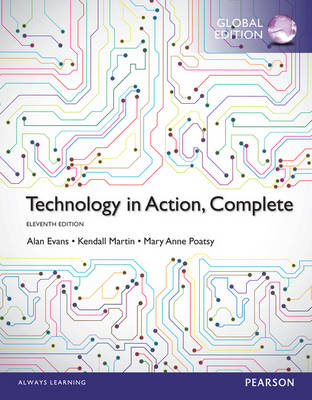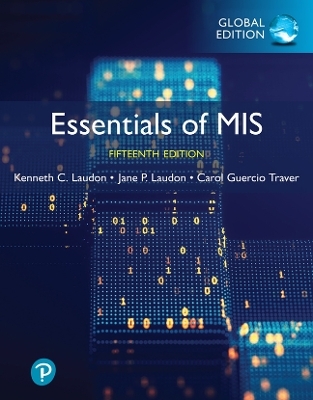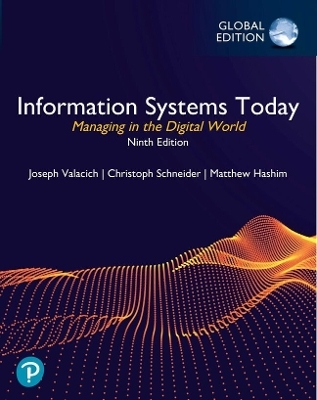
Technology In Action, Complete, Global Edition
Pearson Education Limited
978-1-292-08235-6 (ISBN)
- Titel ist leider vergriffen;
keine Neuauflage - Artikel merken
Explore, discover, and experience technology with the immersive and adaptive Technology in Action-the book that uses technology to teach technology!
Technology in Action is a learning system that pushes the envelope of what is possible in technology, and what is helpful in teaching. It is a system that fits the way students are learning today.
Teaching and Learning Experience
This program presents a better teaching and learning experience-for you and your students. It will help:
Motivate Learning with a Progressive Approach: Students stay engaged because the content focuses on the material they want to learn, while teaching the material they need to learn.
Engage Students with Fun, Timely In-text Features: To engage students and help them understand how and why technology works, they need an approach that piques their curiosity.
Bring Content Alive with Unique Companion Media: Technology in Action uses technology to teach technology with rich companion media that engages students in and out of the classroom while providing essential training on computer concepts.
Support Students and Instructors: A comprehensive set of resources is available for students and instructors.
MyITLab not included. Students, if MyITLab is a recommended/mandatory component of the course, please ask your instructor for the correct ISBN and course ID. MyITLab should only be purchased when required by an instructor. Instructors, contact your Pearson representative for more information.
MyITLab is an online homework, tutorial, and assessment product designed to personalize learning and improve results. With a wide range of interactive, engaging, and assignable activities, students are encouraged to actively learn and retain tough course concepts.
Chapter 1
Using Technology to Change the World
How Will You Put Technology in Action?
Technology on the World Stage
Political Issues
Other Global Issues
ETHICS in IT: The Digital Divide and the Mobile Bridge
Technology and Our Society
Technology Impacts How We Think
Technology Impacts How We Connect
Technology Impacts How We Consume
TRY THIS: Skyping Around the World
How Will Technology Improve Your Life?
Technology at Home
Technology and Your Career
Retail: Working in a Data Mine
Arts: Ink, Paints, and a Laptop?
Education: Teaching and Learning
Law Enforcement: Put Down That Mouse-You're Under Arrest!
Medicine: The Chip Within
DIG DEEPER: Making Reality Even More Real
Science: Simulating Reality
Psychology: Computerized Coach
Chapter 2
Looking at Computers: Understanding the Parts
Understanding Digital Components
Understanding Your Computer
Computers Are Data Processing Devices
Bits and Bytes: The Language of Computers
Types of Computers
Input Devices
Keyboards
Mice and Other Pointing Devices
Image Input
DIG DEEPER: How Touch Screens Work
Sound Input
ETHICS in IT: What Is Ethical Computing?
Output Devices
Monitors
Printers
Sound Output
TRY THIS: What's Inside My Computer?
Processing, Storage, and Connectivity
Processing and Memory on the Motherboard
Memory
Processing
Storing Data and Information
Hard Drives
Cloud Storage
Portable Storage Options
Optical Storage
Connecting Peripherals to the Computer
High-Speed and Data Transfer Ports
Connectivity and Multimedia Ports
Adding Ports: Expansion Cards and Hubs
Power Controls
Setting It All Up
TRENDS in IT: Innovations in Printing
Chapter 3
Using the Internet: Making the Most of the Web's Resources
Working and Playing on the Web
The Internet and How It Works
The Origin of the Internet
How the Internet Works
Communicating and Collaborating on the Web
Social Networking
E-Mail
Instant Messaging
Wikis
Blogs
Podcasts and Webcasts
Web Entertainment
Conducting Business Over the Internet: E-commerce
E-Commerce Safeguards
DIG DEEPER: Discovering the Semantic Web
TRY THIS: Create a OneDrive Account to Store and Share
Your Files in the Cloud
Using the Web Effectively
Accessing and Moving Around The Web
Web Browsers
URLs, Protocols, and Domain Names
Hyperlinks and Beyond
Favorites, Live Bookmarks, and Tagging
TRENDS in IT: Doing Business on a Shoestring-Thanks to the Internet
Searching the Web Effectively
Using Search Engines Effectively
Evaluating Websites
ETHICS in IT: Plagiarism and Copyright Violation: What Can You Borrow from the Internet?
TECHNOLOGY IN FOCUS
The History of the Personal Computer
Chapter 4
Application Software: Programs That Let You Work and Play
Programs That Let You Work
The Nuts and Bolts of Software
TRENDS in IT: Mobile Commerce: What Have You Bought with Your Phone Lately?
Productivity and Business Software
Bundled Productivity Software
Word Processing Software
Spreadsheet Software
Presentation Software
Database Software
Note-Taking Software
Personal Information Manager Software
Microsoft Office Productivity Software Features
Personal Financial Software
ETHICS in IT: Can I Borrow Software That I Don't Own?
Small Business Software
Software for Large and Specialized Businesses
TRY THIS: Citing Website Sources
Programs That Let You Play
Multimedia and Entertainment Software
Digital Image- and Video-Editing Software
DIG DEEPER: How Cloud Computing Works
Digital Audio Software
Gaming Software
Educational and Reference Softvvare
Drawing Software
Managing Your Software
Getting Software
Software Licenses
Getting the Right Software for Your System
Installing and Uninstalling Software
Chapter 5
System Software: The Operating System, Utility Programs, and File Management
Understanding System Software
Operating System Fundamentals
Real-Time Operating Systems
Operating Systems for Networks, Servers, and Mainframes
Operating Systems for Mobile Devices
Operating Systems for Personal Computers
What the Operating System Does
The User Interface
Processor Management
Memory and Storage Management
Hardware and Peripheral Device Management
ETHICS in IT: The Great Debate: Is Mac OS X Safer than Windows?
Software Application Coordination
The Boot Process: Starting Your Computer
Step 1: Activating BIOS
Step 2: Performing the Power-On Self-Test
Step 3: Loading the OS
Step 4: Checking Further Configurations and Customizations
Handling Errors in the Boot Process
TRY THIS: Organizing Tiles on the Start Screen in Windows 8
Using System Software
The Windows Interface
TRENDS in IT: Open Source Software: Why Isn't Everyone Using Linux?
Organizing Your Computer: File Management
Organizing Your Files
Viewing and Sorting Files and Folders
Naming Files
Working with Files
Utility Programs
Display Utilities
The Programs and Features Utility
File Compression Utilities
System Maintenance Utilities
System Restore and Backup Utilities
DIG DEEPER: How Disk Defragmenter Utilities Work
Accessibility Utilities
TECHNOLOGY IN FOCUS
Information Technology Ethics
Chapter 6
Understanding and Assessing Hardware: Evaluating Your System
Evaluating Key Subsystems
Your Ideal Computing Device
Evaluating the CPU Subsystem
How the CPU Works
CPU Factors
Measuring the CPU
Evaluating the Memory Subsystem
The RAM in Your System
Adding RAM
Evaluating the Storage Subsystem
Mechanical Hard Drives
Solid-State Drives
DIG DEEPER: How a Hard Drive Works
Optical Drives
Your Storage Capacity and Needs
TRY THIS: Measure Your System Performance
Evaluating Other Subsystems and Making a Decision
Evaluating the Video Subsystem
Video Cards
TRENDS in IT: Thunderbolt: The New Standard for Data Transfer
Evaluating the Audio Subsystem
Evaluating System Reliability
Making a Final Decision
Getting Rid of Your Old Computer
ETHICS in IT: Free Hardware for All
Chapter 7
Networking: Connecting Computing Devices
How Networks Function
Networking Fundamentals
Network Architectures
Network Architectures Defined by Distance
Network Architectures Defined by Levels of Administration
Ethernet Protocols
Network Components
Transmission Media
Basic Network Hardware
Network Software
Connecting to the Internet
Wired Broadband Internet Connections
Wireless Internet Access
Dial-Up Connections
TRY THIS: Testing Your Wired and Wireless Internet Connection Speeds
Your Home Network
Installing and Configuring Home Networks
Planning Your Home Network
Connecting Devices to a Router
Network-Attached Storage Devices
TRENDS in IT: Where Should You Store Your Files? The Cloud Is Calling!
Home Network Servers
Digital Entertainment Devices on a Network
Specialized Home-Networking Devices
Configuring Software for Your Home Network
Troubleshooting Wireless Network Problems
ETHICS in IT: Sharing Your Internet Connection with Your Neighbors: Legal? Ethical? Safe?
Securing Wireless Networks
TECHNOLOGY IN FOCUS
Under the Hood
Chapter 8
Digital Devices and Media: Managing a Digital Lifestyle
Mobile Devices
Digital Convergence
Telephony: Smartphones and Beyond
Smartphone Basics
Smartphone Components
How Cell Phone Technology Works
Synchronizing
Text Messaging
Mobile Internet
Smartphone Security
VoIP
Smartphone GPS
Tablets, Netbooks, and Ultrabooks
Tablets
Netbooks
Ultrabooks
Making a Choice
TRY THIS: Creating and Publishing a Movie
The Digital Information Age
Digital Defined
TRENDS in IT: NFC Chips: Do You Have a Digital Wallet?
Digital Media
Digital Publishing
Digital Music
Digital Photography
DIG DEEPER: The Shift to Digital Music: A Bumpy Ride
Digital Video
ETHICS in IT: Managing Your Copyrights: Copyleft Might Simplify Your Life
Chapter 9
Securing Your System: Protecting Your Digital Data and Devices
Major Threats to Your Digital Assets
Cybercrime and Identity Theft
Computer Viruses
Catching a Virus
Boot-Sector Viruses
Logic Bombs and Time Bombs
Worms
Script and Macro Viruses
E-Mail Viruses
Encryption Viruses
Additional Virus Classifications
Virus Symptoms
Preventing Virus Infections
Antivirus Software
Software Updates
Understanding Hackers
Problems Hackers Can Cause
Trojan Horses and Rootkits
Denial-of-Service Attacks
How Hackers Gain Computer Access
Restricting Access to Your Digital Assets
Firewalls
Types of Firewalls
How Firewalls Work
Knowing Your Computer Is Secure
Password Protection and Password Management
Creating Passwords
Managing Your Passwords
Anonymous Web Surfing: Hiding from Prying Eyes
Biometric Authentication Devices
TRY THIS: Testing Your Network Security
Protecting Your Digital Property from Yourself
Managing Online Annoyances
Malware: Adware and Spyware
Spam
DIG DEEPER: Computer Forensics: How It Works
Cookies
ETHICS in IT: You're Being Watched ... But Are You Aware You're Being Watched?
Keeping Your Data Safe
Protecting Your Personal Information
Backing Up Your Data
Social Engineering
Phishing and Pharming
Scareware
TRENDS in IT: Computers in Society: Spear Phishing: The Bane of Data Breaches
Protecting Your Physical Computing Assets
Environmental Factors
Power Surges
Deterring Theft
Keep Them Safe: Alarms
Keeping Mobile Device Data Secure
Software Alerts and Data Wipes
TECHNOLOGY IN FOCUS
Careers in IT
Chapter 10
Behind the Scenes: Software Programming
Understanding Software Programming
The Importance of Programming
The Life Cycle of an Information System
The System Development Life Cycle
The Life Cycle of a Program
Describing the Problem: The Problem Statement
Making a Plan: Algorithm Development
Developing the Algorithm: Decision Making and Design
Top-Down Design
Object-Oriented Analysis
DIG DEEPER: The Building Blocks of Programming Languages: Syntax,
Keywords, Data Types, and Operators
Coding: Speaking the Language of the Computer
Compilation
Coding Tools: Integrated Development Environments
Debugging: Getting Rid of Errors
Testing and Documentation: Finishing the Project
TRY THIS: Programming with Corona
Programming Languages
Many Languages for Many Projects
Selecting the Right Language
ETHICS in IT: When Software Runs Awry
Exploring Programming Languages
Visual Basic
C and C++
Java and C#
Objective C
HTML
JavaScript and VBScript
ASP, JSP, and PHP
AJAX and XML
Mobile Applications
TRENDS in IT: Emerging Technologies: Unite All Your Video Game Design Tools
The Next Great Language
Chapter 11
Behind the Scenes: Databases and Information Systems
Database Basics
Database Building Blocks
Databases Versus Lists
Advantages of Using Databases
Database Management Systems
Database Terminology
Planning and Creating the Database
Using Primary Keys
Database Types
Relational Databases
Object-Oriented Databases
Multidimensional Databases
Database Functions
Inputting Data
Data Validation
Viewing and Sorting Data
Extracting or Querying Data
DIG DEEPER: Structured Query Language (SOL)
Outputting Data
TRY THIS: Using Excel's Database Functions
How Businesses Use Databases
Data Warehousing and Storage
Data Warehouses
TRENDS in IT: Emerging Technologies: Can Your Business Partner
Deliver the Goods? Enhanced Databases Can Help You Decide!
Populating Data Warehouses
Data Staging
Data Marts
Business Intelligence Systems
Office Support Systems
Transaction-Processing Systems
Management Information Systems
Decision Support Systems
Enterprise Resource Planning Systems
TRENDS in IT: Computers in Society: User-Populated Databases
Data Mining
ETHICS in IT: Data, Data Everywhere-But Is It Protected?
Chapter 12
Behind the Scenes: Networking and Security in the Business World
Client/Server Networks and Topologies
Client/Server Network Basics
Networking Advantages
Comparing Client/Server and Peer-to-Peer Networks
Types of Client/Server Networks
Servers
Authentication and File Servers
Print Servers
Application Servers
Database Servers
E-Mail Servers
Communications Servers
Web Servers and Cloud Servers
TRENDS in IT: Virtualization: Making Servers Work Harder
Network Topologies
Bus Topology
Ring Topology
Star Topology
Comparing Topologies
TRY THIS: Sharing Folders on a Home Network
Setting Up Business Networks
Transmission Media
Wired Transmission Media
Twisted-Pair Cable
Coaxial Cable
Fiber-Optic Cable
Wireless Media Options
Comparing Transmission Media
Network Adapters
Network Navigation Devices
MAC Addresses
Switches and Bridges
Routers
Network Operating Systems
DIG DEEPER: The OSI Model: Defining Protocol Standards
Client/Server Network Security
Authentication
Access Privileges
Physical Protection Measures
ETHICS in IT: How Should Companies Handle Data Breaches?
Firewalls
Chapter 13
Behind the Scenes: How the Internet Works
Inner Workings of the Internet
The Management of the Internet
Internet Networking
Internet Data Routes
The Network Model of the Internet
Data Transmission and Protocols
Circuit Switching
Packet Switching
TCP/IP
Internet Identity: IP Addresses and Domain Names
IP Addresses
DIG DEEPER: Connection-Oriented Versus Connectionless Protocols
Domain Names
TRY THIS: Ping Me
Coding and Communicating on the Internet
HTML, XML, and Other Web Building Blocks
HTML
XML and JSON
Web Browser Protocols
Server-Side Applications
Client-Side Applications
Communications Over the Internet
E-Mail
E-Mail Security: Encryption
ETHICS in IT: Web Browsing: Not as Private as You May Think
Instant Messaging
TRENDS in IT: Crowdsourcing: Harnessing the Power of Social Networks
Glossary
Index
| Verlagsort | Harlow |
|---|---|
| Sprache | englisch |
| Maße | 217 x 275 mm |
| Gewicht | 900 g |
| Themenwelt | Schulbuch / Wörterbuch |
| Mathematik / Informatik ► Informatik | |
| Mathematik / Informatik ► Mathematik ► Finanz- / Wirtschaftsmathematik | |
| ISBN-10 | 1-292-08235-6 / 1292082356 |
| ISBN-13 | 978-1-292-08235-6 / 9781292082356 |
| Zustand | Neuware |
| Haben Sie eine Frage zum Produkt? |
aus dem Bereich


